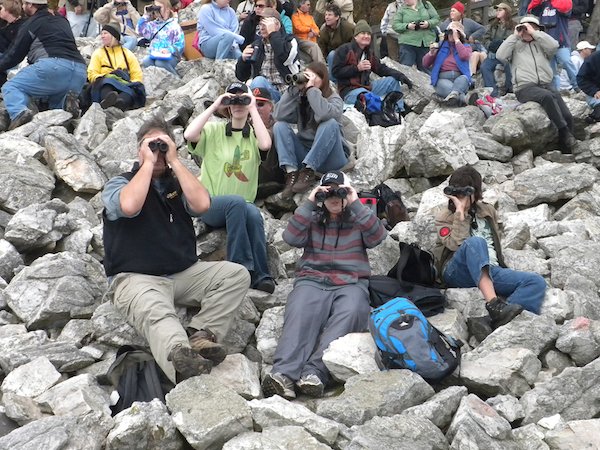
Calling all hawkeyes! North America is in the prime of raptor migration season, with millions of hawks, accipters, and buteos flying south for the winter. But for the average birder, these soaring raptors may not always be easy to see; lots of patches that are good for seeing other birds feature trees and other impediments to the wide-open skies that are necessary for the best raptor-watching experience.
Enter the Audubon Society. The organization has just released a map to the best raptor-watching sites in the United States. It features spots, associated with Audubon centers or contributed by individual birders, which may afford views of thousands of birds a day. With the easily navigable map, birders in most parts of the country should be able to find a close-to-home hawkwatch. (The image above is James Currie’s, from Hawk Mountain in Pennsylvania.)
I’ve been fortunate enough to enjoy outings to two hotspots that aren’t yet on the map: Chestnut Ridge Hawkwatch in Bedford, NY, and Illinois Beach State Park in Zion, Illinois. I didn’t happen to hit these sites on jackpot days, when virtual rivers of southbound raptors fill the skies (and site monitors risk carpal tunnel syndrome from clicking off so many birds), but I still found them to be wonderful, whether the highlight was an American Kestrel whizzing just feet above my head, some Merlins buzzing each other, or applauding as the daily raptor total surpassed the 1,000-bird mark. Even on not-so-birdy days, the camaraderie of other birders, and the chance to just park oneself on a picnic table or bleacher seat is a welcome change from the lonely walks in the woods that birding can often be.
So if you have the opportunity to check out a raptor watch, don’t miss it. And if the Audubon map didn’t highlight your favorite hotspot, please add it to the map (and feel free to share it in the comments section). Because the only thing cooler than raptors is kettles and kettles of raptors.













Cool idea, but Audubon needs to have someone vet the sightings and remove some of the more “off” ones. In Michigan there’s a report for Jackson, MI that is placed 150 miles north of Jackson and reports a Perigrine [sic] Hawk.